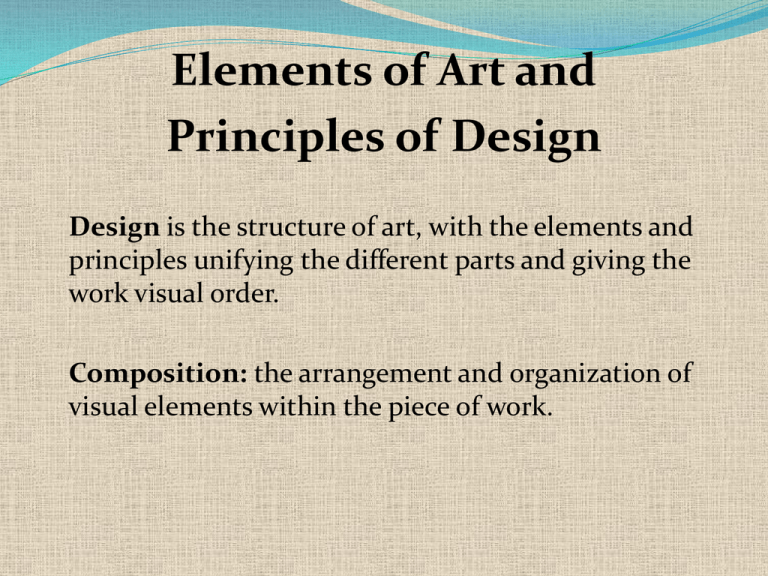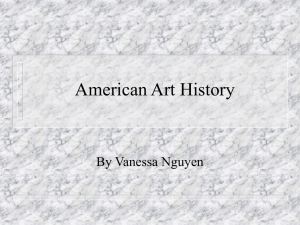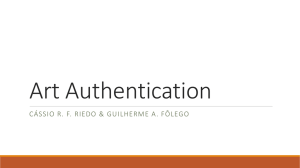Elements of Art and Principles of Design Design is the structure of
advertisement

Elements of Art and Principles of Design Design is the structure of art, with the elements and principles unifying the different parts and giving the work visual order. Composition: the arrangement and organization of visual elements within the piece of work. Elements of Art: Line, Shape, Form, Color, Value, Texture, Space The basic elements that are used by artists in creating works of art; they are what you use to create a good composition. If we want to make art, we need to understand these seven elements of art. 1. Line – the mark made by a moving point. People use lines to write words and artists draw lines with pencils or other tools. Take a look at the drawing by Ben Shahn, titled “The Supermarket.” As you can see, line plays a very large role in his overall piece. The use of vertical, diagonal, and horizontal are all used to create the shopping carts. Another great image displaying the use of line as a key element is in The Peacock Skirt, by Aubrey Beardsley. How are the lines different from that of the shopping carts? The mood is drastically changed by the soft, flowing lines in the clothing worn by the women. 2. Shape – is a flat, enclosed line or area that has two dimensions – length and width. Picasso was another famous painter in the 20th century. Look at all the shapes in his painting, The Lesson. There are triangles, squares, circles, and many other shapes. Piet Mondrian, Compostion No. 2 Wassily Kandinsky, Merry Structure What shapes do you primarily see in the above paintings? Are they soft and round, or more angular and geometrical? What type of feeling does it create? Both Mondrian and Kandinsky were famous for their abstract paintings they created in the 20th century. Kandinsky’s painting, Merry Structure, definitely lives up to its title. The playful shapes create a fun image, while Mondrian’s painting is more serious, consisting of only squares and rectangles. 3. Form – three dimensional space, volume, mass. Objects that are 3-D have length, width, and height. It can be viewed from many sides. Marcella Smith Todd King 4. Color – how eyes perceive reflected light off an object. There are three properties of color – hue (the name of the color), Value ( the light or dark of the color, also known as shades and tints), and intensity ( refers to the brightness of the color). Artist value “Color” as an important Element of Art. It is a wonderful tool to create mood in a piece of art. The effect of color can have a strong impact on your feelings. In art, dark colors often depict sadness, while cheerful bright colors are used for happiness. Study these paintings. Does it represent happiness or sadness? Paris, a Rainy Day, 1877 by Gustave Caillebotte Dogwood by by Albert Bierstadt The Red Vineyard at Arles, c.1888 Sunflowers, c.1888 by Vincent Van Gogh Sunflowers, c.1888 by Vincent Van Gogh by Vincent Van Gogh 5. Value – degrees of lightness or darkness. 6-Texture -refers to the way the surface feels on an object or painting. Artists can create texture by using a paint brush, palette knife, or any type of tool or medium they would like. Van Gogh was known for his heavy impasto, created by applying lots of paint with a brush or even a palette knife. The texture in Starry Night makes the painting look like it has movement. Vincent Van Gogh, Starry Night Paul Klee, Ad Parnassem French artist, Paul Klee, is famous for his abstract paintings. With color, simple shapes and textures, Klee is able to make his work interesting and enjoyable to look at. 7. Space - refers to the emptiness or area between, around, above, below, or within objects. Space can be two-dimensional, three-dimensional, negative and/or positive. Principles of Design: Unity (harmony), Pattern, Emphasis, Balance, Movement, Rhythm, Proportion, Contrast Standards or rules to be observed by artists in creating works of art; they are how to create a good composition. 1. Unity (Harmony) – visually pleasing agreement among the elements in a design; It is the feeling that everything in the work of art works together and looks like it fits. The Elements Of Art used to create the artwork should appear to create a "whole" image, not just a series of independent Elements. Artists use certain Elements Of Art over again and again to create a sense of Harmony. Using related colors, repeating lines and shapes and themes will also make the work appear Harmonious. When you look at a work and sense that the piece is complete, you can appreciate the importance of Unity. We can create harmony with color to help us build a particular relationship between the colors on the palette. When colors are harmonized the relationship that is established allows the colors to work together, sharing something in common. This painting by, Balthasar van der Ast shows total harmony in all areas. 2. Pattern- is simply keeping your design in a certain format. For example, you could plan to have wavey lines all around your design as a pattern, but then you must continue those wavey lines throughout the design for good patterns. It wouldn't look good if suddenly you stopped all the wavey lines and drew a picture of a dog. 3. Emphasis (Focal Point) – Artists use emphasis to make certain parts of their artwork stand out and grab your attention. The center of interest or focal point is the place the artist draws your eye to first; meant to stand out to draw attention to the area. 4. Balance – distribution of visual weight and interest. Symmetrical (formal) balance refers to using the exact same characteristics in the same position on either side of the composition; like a mirror image. Asymmetrical (informal) by using different equally attracting features on either side of the composition. Radial Balance is when the elements radiate from the center. Symmetrical (formal) Balance: Asymmetrical (informal) Balance: By color: By shape: By position; By texture: Radial Balance: 5. Movement – how the eye moves through the composition; leading the attention of the viewer from one aspect of the work to another. Can create the illusion of action. 6. Rhythm – regular repetition of, or alternation in elements to create movement and interest. 7. Proportion – size relationships of one part to another part or to the whole. When the principle of proportion is applied to a work of art it is usually in the relationship of size. In the instance of a relationship of size, a comparison is made between the: height, width and depth of one element to that of another size of another element. Proportion is usually not even noticed until something is out of proportion. When the relative size of two elements being compared seems wrong or out of balance it is said to be "out of proportion". For example if a person has a head larger than their entire body, then we would say that they were out of proportion. There is a real sense of proportion in each of the two paintings above. Without the effective use of the principle of proportion you would not experience the majesty of the mountain cliffs in the painting on the left or the towering height of the trees in the painting on the right. In the two paintings above proportion emphasizes the distance of the ship and the vastness of the ball room. 8. Contrast - in art and design occurs when two related elements are different. The greater the difference the greater the contrast. Contrast adds variety to the total design and creates unity. It is what draws the viewer's eye into the painting and helps to guide the viewer around the art piece. Contrast in art also adds visual interest. Most designs require a certain amount of contrast. Too much similarity of the components in any design becomes monotonous. In other words the use of too little contrast can cause a design to be bland and uninteresting. On the other hand too much contract can be confusing. Just the right amount of contrast engages the viewer's participation in comparing various components of the work. Light & dark contrast Subtle contrast Texture contrast









